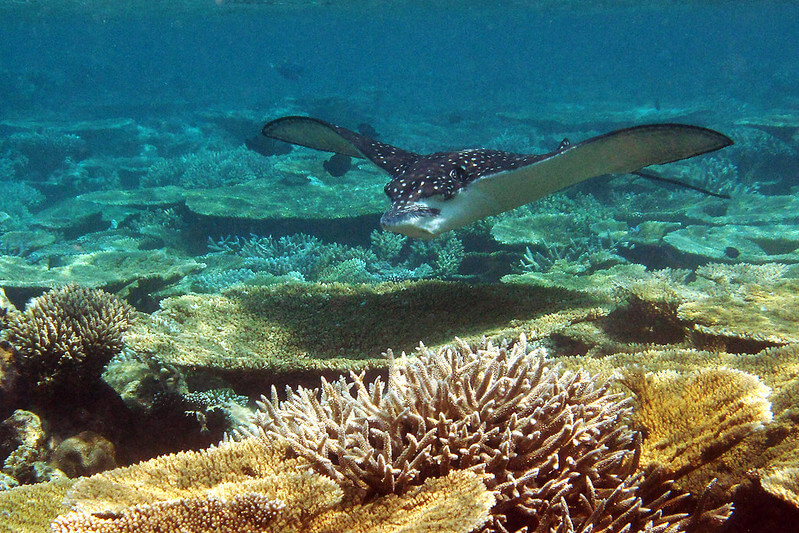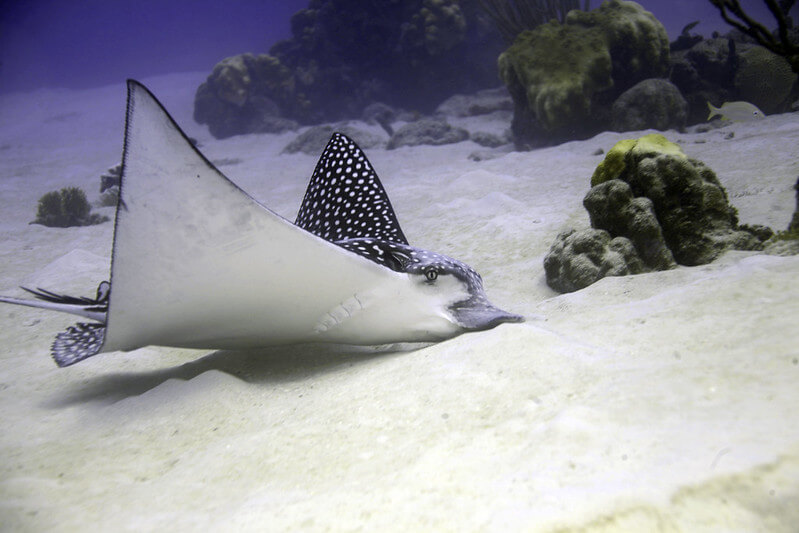Eagle rays are some of the most stunning animals in the ocean. They can be easily identified by their black surface which is covered in white spots or rings.
Spotted eagle rays can grow to a maximum length of 16.4 feet and be found in many tropical, warm, and temperate waters.
Whilst these giant rays may look menacing at first glance, a question that often comes up when discussing these rays is “do eagle rays sting?”
YES, eagle rays can deliver a painful sting as they have a whip-like tail that can have up to seven venomous barbs attached to it. It’s highly unlikely to be stung by an eagle ray, but it can happen.
Let’s take a closer look…
Do Eagle Rays Really Sting?
Spotted eagle rays are armed with a venomous stinger that they use to protect themselves from predators and use as a form of defense if required.
The good news is that these animals are very shy and timid by nature, so the likelihood of a diver being stung by an eagle ray is very slim.

If an eagle ray feels provoked or threatened, there’s more chance of the ray fleeing instead of striking with its barb.
Nevertheless, it’s important always to be vigilant around eagle rays because of their barb.
Eagle Rays Stinger
Eagle rays have long whip-like tails that are much longer than the tails of other stingray species.
Their tail is equipped with a barb at the base which can have anywhere from 2 – 7 venomous spines attached which are used to poison their prey.
An eagle rays tail can reach lengths of 2.5 – 3x the width of the diamond-shaped pectoral disc.
Their tails are so long that oftentimes they break, but an unbroken tail can be enormous and a real hazard for these rays.
At the base of the tail is a venomous barb or stinger that is capable of inflicting a serious wound and delivering powerful toxins that can cause serious injury.
They use these stingers to protect themselves from predators. Sharks, seals, orcas, and even large fish are always on the lookout for a stingray meal, so these barbs come in handy for protection.
Why Might An Eagle Ray Sting?
The chances of being stung by an eagle ray are incredibly slim, but if the ray feels provoked, threatened, or intimidated it may defend itself.
Eagle rays use their stinger regularly to protect themselves from attacking predators such as those mentioned above, but it’s INCREDIBLY rare for them to attack a human.
These rays are timid, so they don’t enjoy being up close and personal with divers. Invading their personal space may cause them to lash out, so I would never advise getting too close to eagle ray.
It’s not a good idea to try and touch, grab, or pet an eagle ray either. They may take this as a threat and could react.
These animals are covered in a mucous-like film that protects them from bacteria, therefore, touching them can rub this off and leave them exposed to harmful bacteria.
If you are lucky enough to come across an eagle ray in the wild, remember these safety tips:
- Keep your distance
- NEVER touch, grab, or pet
- Do not swim directly above rays
- No sudden movements
- Avoid flashing cameras
Are Eagle Ray Attacks Rare?
YES, eagle ray attacks are incredibly rare and after searching online I couldn’t find a single case of a purposeful attack.
There was an incident over a decade ago where a large 75-pound eagle ray leaped from the water whilst a woman was traveling 25 miles per hour in her boat in the Florida keys.
The woman, Judy Kay Zagorski, 57, tragically died from the incident, likely from the impact of the huge ray landing on her face.
Eagle rays can weigh as much as 500 pounds and have a wingspan of up to 10 feet, they’re no small animal and occasionally do leap out of the water.

Aside from this incident, I was unable to find any other eagle ray attack, and instead mostly found fascinating stories where people had swum with these rays and had wonderful experiences.
So long as these animals are treated with the respect they deserve, divers, snorkelers, and others are safe around eagle rays and do not need to fear being attacked.
Final Thoughts
Now that we know more about eagle rays and how they behave, hopefully, you have a clear answer to your question “do eagle rays sting?“
Whilst these beautiful rays do have a barb that is equipped with toxic spikes, it’s highly unlikely that these rays would attack a human, and only use their barb in self-defense.
Eagle rays are shy, non-aggressive rays that actively avoid contact with humans. They keep themselves to themself and are not out to hurt anybody.
That said, accidents do happen, so it’s wise to remember the crucial safety steps set out above to be sure that you have a wonderful experience if you ever encounter an eagle ray in the wild.
Thanks for taking the time to read this post, catch you in the next one!

Hi, I’m George – the founder of MarinePatch. I created this blog as marine wildlife has been my passion for many years. I’ve spent over a decade in the marine wildlife industry and spent years out in the field conducting research. In today’s modern world, an online blog is the best place for me to share my findings and reach as many people as possible to help educate and inspire others. Enjoy your time here and you’re welcome back anytime!

